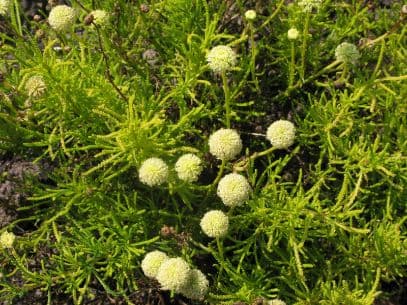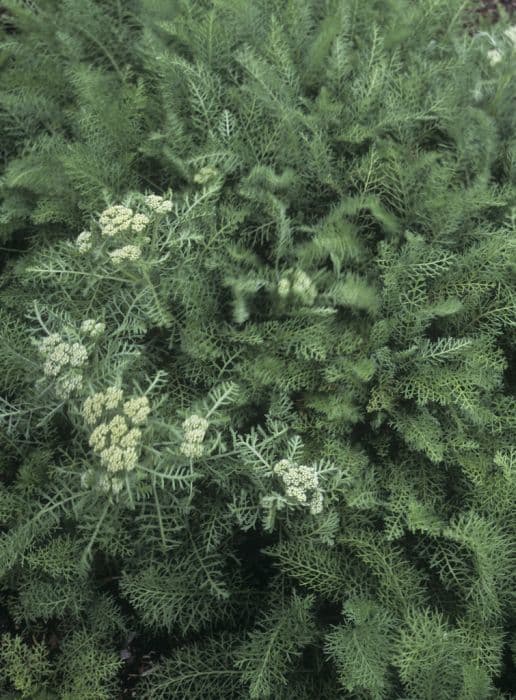Lemon Fizz Santolina Santolina rosmarinifolia 'Lemon Fizz'

ABOUT
Santolina rosmarinifolia 'Lemon Fizz', commonly known as Lemon Fizz Santolina or Lavender Cotton, presents a vibrant landscape addition, thanks to its bright, chartreuse to lemon-yellow foliage. This perennial plant has fine, needle-like leaves that give it a bushy, cushioned appearance. The richly-colored leaves offer a lively contrast and add a splash of sunshine to any garden setting. The foliage of Lemon Fizz Santolina emits a pleasant, aromatic scent when brushed against or crushed, which can remind one of a mix of green apples and pine. During the warmer months, Lemon Fizz Santolina produces button-like, sunny to golden-yellow flowers that stand proudly above the foliage on slender stems. These small, spherical blooms add an extra touch of visual interest and charm to the plant. Lemon Fizz Santolina tends to form a rounded, compact shape, which makes it a perfect choice for borders, rock gardens, or as an accent in mixed plantings. Its fine-textured leaves provide a delicate backdrop to its bolder blossoms, and the overall appearance of the plant exudes both brightness and softness, making it an attractive addition to any space that could use a pop of color and evergreen presence.
About this plant
 Names
NamesSynonyms
Lemon Fizz Santolina, Green Lavender Cotton, Lemon Queen.
Common names
Santolina rosmarinifolia 'Lemon Fizz'.
 Toxicity
ToxicityTo humans
Santolina, commonly referred to as lavender cotton, is not generally known to be highly toxic to humans. There is little information suggesting severe toxicity upon ingestion. However, as with many plants, it could potentially cause mild stomach upset, nausea, or vomiting if ingested in significant amounts due to the plant's bitter taste and potential irritants. Always exercise caution and keep plants out of reach of small children who might chew on them.
To pets
Lavender cotton is not commonly listed as a toxic plant to pets such as dogs and cats. While it is not expected to be seriously poisonous, ingestion could potentially lead to mild gastrointestinal upset, as is the case with many non-toxic plants. It is always prudent to prevent your pets from ingesting plants as individual sensitivity could vary. If you notice any adverse reactions in your pet after ingestion, consult a veterinarian.
 Characteristics
CharacteristicsLife cycle
Perennials
Foliage type
Evergreen
Color of leaves
Yellow-green
Flower color
Yellow
Height
1-2 feet [30-60 cm]
Spread
2 feet [60 cm]
Plant type
Shrub
Hardiness zones
6
Native area
Mediterranean
Benefits
 General Benefits
General Benefits- Aesthetic Appeal: 'Lemon Fizz' provides a pop of color with its bright lemon-lime foliage, making it a visually stimulating addition to gardens and landscapes.
- Drought Tolerance: Once established, it requires minimal watering, making it suitable for xeriscaping and drought-prone areas.
- Low Maintenance: This plant typically requires very little pruning or care once it has settled into its environment.
- Pest Resistance: It is known to be resistant to many common garden pests, reducing the need for chemical treatments.
- Tolerant of Poor Soils: Adapts to a range of soil types, including poor soils, as long as they are well-draining.
- Dense Growth Habit: The plant's dense growth can help suppress weeds, reducing garden maintenance requirements.
- Long Blooming Period: It produces small, button-like yellow flowers that add interest over an extended period in the summer.
- Attracts Pollinators: The flowers can attract beneficial insects such as bees and butterflies, promoting biodiversity.
- Edging and Borders: Its mounding habit and neat appearance make it an excellent choice for edges and borders in garden design.
 Medical Properties
Medical PropertiesThis plant is not used for medical purposes.
 Air-purifying Qualities
Air-purifying QualitiesThis plant is not specifically known for air purifying qualities.
 Other Uses
Other UsesSantolina rosmarinifolia 'Lemon Fizz', commonly known as Lemon Fizz Santolina, can be used as a natural dye for fabrics due to the color of its foliage.
Its compact and textured form can be incorporated into topiary gardens, providing a contrast to other plants when shaped and pruned.
Lemon Fizz Santolina is often used in knot gardens for its ability to maintain a dense, low-growing form, perfect for intricate patterns.
The plant can be included in sensory gardens because of its aromatic leaves, which release a scent when touched.
In xeriscaping, Lemon Fizz Santolina is appreciated for its drought tolerance, adding greenery with minimal water usage.
Its vibrant foliage can be used to create a colorful, low-maintenance ground cover that suppresses weeds and reduces soil erosion.
Lemon Fizz Santolina works well in rock gardens, adding texture and a pop of color amidst stones and gravel.
The plant can serve as an indicator of soil health; it thrives in well-draining soil, signaling when the ground might be too compacted or poorly drained.
In coastal gardens, Lemon Fizz Santolina can tolerate salt spray and sandy soil, making it a versatile choice for seafront landscapes.
The leaves can be used as a natural filler in floral arrangements, providing a long-lasting, lemony-green accent.
Interesting Facts
 Feng Shui
Feng ShuiThe plant Santolina is not used in Feng Shui practice.
 Zodiac Sign Compitability
Zodiac Sign CompitabilityThe plant Santolina is not used in astrology practice.
 Plant Symbolism
Plant Symbolism- Protection: Santolina, commonly known as lavender cotton, has traditionally been used in gardens to ward off harmful insects and pests, symbolizing safety and a protective barrier. 'Lemon Fizz', with its bright lemon-colored foliage, ties this symbol of protection with vibrancy and energy.
- Longevity: With its association to the perennial herb family and its resilience, lavender cotton is often seen as a symbol of longevity and endurance, embodying the plant's ability to thrive in challenging conditions and poor soils.
- Purification: The aromatic nature of Santolina rosmarinifolia 'Lemon Fizz', much like its close relatives in the herb garden, points to its use in ancient times for purification purposes, representing cleansing and renewal of spaces.
- Health: Historically, various species of Santolina were believed to have medicinal properties. This association imparts the symbolic meaning of health and well-being to the 'Lemon Fizz' variety as well.
 Water
WaterThe Green Lavender Cotton 'Lemon Fizz' prefers to be watered moderately, with deep watering sessions to encourage root growth and then allowing the soil to dry out somewhat before the next watering. Typically, watering once a week is sufficient, but this can vary depending on climate conditions and soil type; in hot, dry weather, it may require twice a week. Use approximately one gallon of water per plant for each watering session, ensuring you're watering the base and not the foliage to prevent mildew. Adjustments should be made during the rainy season or in cooler weather to prevent waterlogging, which can lead to root rot.
 Light
LightThe Green Lavender Cotton 'Lemon Fizz' thrives in full sun conditions, preferring to receive at least 6 hours of direct sunlight each day. The best spot for this plant is in an area where it's exposed to unfiltered sunlight for the majority of the day. While it can tolerate partial shade, its growth might not be as robust, and it may produce fewer flowers.
 Temperature
TemperatureThe Green Lavender Cotton 'Lemon Fizz' can survive in a temperature range between 30°F and 90°F but prefers a comfortable range of 60°F to 80°F for ideal growth conditions. It's a hardy plant that can withstand light frost, but prolonged exposure to temperatures below freezing can be harmful.
 Pruning
PruningThe Green Lavender Cotton 'Lemon Fizz' should be pruned to maintain its shape and to encourage new growth. Prune lightly in early spring just before new growth begins. Pruning can be done again after flowering to remove spent flowers and to thicken the plant. It's generally advised to prune this plant once or twice a year, as excessive pruning can harm the plant.
 Cleaning
CleaningAs needed
 Soil
SoilFor Lemon Queen, prepare a well-draining soil mix with coarse sand, peat, and some compost to enhance fertility. The ideal soil pH for Lemon Queen is between 6.5 and 7.2.
 Repotting
RepottingLemon Queen should be repotted every 2-3 years or when it outgrows its current pot to ensure continued growth and health.
 Humidity & Misting
Humidity & MistingLemon Queen thrives in average room humidity conditions; avoid overly humid or dry environments for optimal growth.
 Suitable locations
Suitable locationsIndoor
Place Lemon Queen in bright light, let soil dry between waterings.
Outdoor
Grow Lemon Queen in full sun, well-drained soil, and shelter from wind.
Hardiness zone
6-9 USDA
 Life cycle
Life cycleSantolina rosmarinifolia 'Lemon Fizz', commonly known as Lemon Fizz Santolina, begins its life as a seed, which upon germination produces a small seedling with tender leaves. This seedling then grows into a juvenile plant, establishing itself with a root system and foliage in a rosette pattern. As it matures, Lemon Fizz Santolina enters the vegetative stage, developing a woody base, silver-green leaves, and a bushy growth habit. Upon reaching the flowering stage, typically in the early to mid-summer, the plant produces bright yellow, button-like flowers that are attractive to pollinators. After pollination, seeds are developed and subsequently dispersed, initiating the next generation. Finally, the plant enters senescence, where growth slows and the plant may die back, especially in colder climates, although it is a perennial and often survives to regrow in the spring.
 Propogation
PropogationPropogation time
Spring-Early Summer
The most popular method of propagating Santolina rosmarinifolia 'Lemon Fizz', also known as Lemon Fizz Santolina, is through softwood cuttings. This technique is best performed in late spring or early summer when new growth is vigorous and pliable. Take cuttings from new growth, around 3 to 5 inches long, snipping just below a leaf node. Strip the lower leaves off and dip the cut end into a rooting hormone powder to encourage root development. Then insert the cuttings into a mix of equal parts perlite and peat moss, or a well-draining potting mix. Place the pot in a warm, bright area out of direct sunlight and maintain the moisture of the growing medium until roots establish, which typically takes 4 to 6 weeks. After rooting, the young plants can be transplanted into individual pots or into the garden to grow on.









